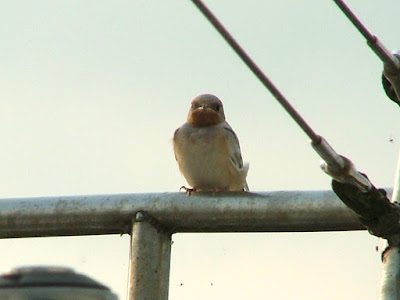Several moth enthusiasts joined in a mothing evening at the country park on Friday 9th as part of National Moth Night - the annual celebration of moth recording. Luckily the weather was favourable, staying dry and with a light breeze blowing. Six traps were placed at various spots close to the car park area, this one pictured belonging to David Barnard.
Over sixty species of macro moth were recorded during the night which was a good tally considering how poor the spring has been for moths up until a couple of weeks ago.

The highlight was the number of cream-spot tiger moths -fourteen of them dropping in during the first half of the night. Pictured above is the full set of them, posing nicely for a team photo!
It was reassuring to see that most were freshly marked individuals and that the cold spring hadn't affected the numbers too much.
Cold springs in recent years has led to a decrease in numbers being seen at the park. The last double digit catch was almost eight years ago when twelve were noted in one night.
This year's target species for National Moth Night were the hawkmoths and it was good to see a few of them on the night at the park. The first hawkmoth to show was the lime hawkmoth, followed a bit later in the night by a second one.
The poplar hawkmoth also showed up before midnight, with three being noted by dawn.
One eyed hawkmoth was found in one of the traps at dawn, sadly missed by those who'd gone home at midnight.
Just after midnight three of the brightly coloured elephant hawkmoths made an appearance.
A green silver lines dropped in early in the evening, providing a splash of green colour to the proceedings.
The beautiful hook-tip seems to have become more established at the park in recent years.
The sand dart is noted each year at the park, a coastal species round the UK, it's larvae feed on various sand-dune plants.

The saltmarsh plume has a very distinctive posture with its long front legs and narrow wings pointing forwards.
Other macro-moths noted on the night included common swift, oak hook-tip, figure of 80, treble brown spot, common carpet, purple bar, pine carpet, common marbled carpet, sandy carpet, common pug, clouded border, brimstone, scorched wing, peppered moth, willow beauty, pale oak beauty, clouded silver, light emerald, yellow belle, swallow prominent, pale prominent, marbled brown, pale tussock, bufftip, buff ermine, white ermine, cinnabar, least black arches, heart and dart, shuttle-shaped dart, large yellow underwing, ingrailed clay, setaceous Hebrew character, nutmeg, shears, bright-line brown-eye, white-point, common wainscot, shoulder-striped wainscot, poplar grey, grey dagger, knot-grass, angle shades, dark arches, marbled minor, middle-barred minor, rustic shoulder knot, Vine's rustic, mottled rustic, snout and straw dot.













































